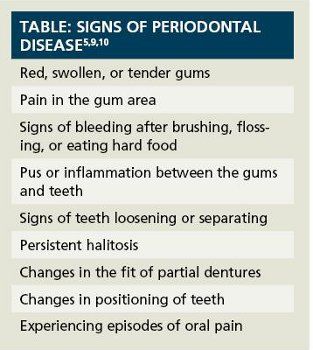Publication
Article
Pharmacy Times
Benefits of Good Oral Hygiene
Author(s):
The prevention of plaque and tartar buildup can boost overall health.
The prevention of plaque and tartar buildup can boost overall health.
Maintaining good oral health is essential to maintaining good overall health. The goal of proper oral hygiene is to remove or prevent formation and buildup of plaque and tartar, to prevent dental caries and periodontal disease, and to decrease the incidence of halitosis.1-4
Results of patient surveys clearly demonstrate that many are unaware of the importance of practicing good oral hygiene and its connection to overall health. For example, results from a May 2012 survey conducted by the American Dental Association regarding oral health found that many people are not certain of basic information regarding proper dental care, recommended replacement time frame for toothbrushes, and causes of dental caries.1 In addition, new findings from the Centers for Disease Control and Prevention (CDC) show that approximately 50% of people 30 years and older have some degree of periodontal disease.2,3 Routine oral health is important, but only an estimated 44.5% of people obtain professional dental care on a regular basis.4,5 Clinical studies have shown that those with poor oral hygiene are at increased risk of developing various oral health problems. Poor oral hygiene is directly responsible for increased incidence of dental caries, periodontal disease, halitosis, oral pain, and discomfort for denture wearers.4 In addition, some clinical studies have indicated a link between some oral cancers and poor dental and oral hygiene.5
Fortunately, there are a range of nonprescription dental care products available for the prevention of many common oral health problems. These products are available in various formulations of dentifrices, which include those designed to fight plaque, gingivitis, and tartar, as well as those designed for sensitive teeth or for whitening the teeth. Other products include flosses, topical fluorides, and cosmetic and therapeutic mouth rinses. There are also a number of products that are specially designed for the pediatric population, which encourage and aid in improving brushing techniques. In addition to these products, manual and electric toothbrushes, dental flosses, and oral irrigating devices are often used and recommended for plaque removal.
Pharmacists are in a critical position to increase awareness of the benefits of good oral health care and can emphasize the importance of adhering to a daily preventive oral care regimen. They can also serve as a source of information for patients on the selection and proper use of these nonprescription oral hygiene care products. In addition, pharmacists can aid in identifying patients who are at increased risk of dental problems due to their use of particular pharmacologic agents or the fact that they are affected by certain medical conditions.
Periodontal Disease

Periodontal disease occurs in mild to severe forms. Gingivitis is the mildest form of periodontal disease and is generally reversible. Periodontitis, which is more severe, can occur when gingivitis is left untreated and can result in major, irreversible damage to the soft tissue and bone structure of the teeth. Periodontitis is considered the primary
cause of tooth loss among adults over 45 years of age.4,6,7 Results from a range of studies also provide evidence that periodontal disease is linked to chronic health conditions such as stroke, cardiovascular disease, diabetes, respiratory disease, and pre-term low weight babies.4-6 Mechanically removing plaque buildup by brushing at least twice a day, flossing daily, and obtaining routine dental care is critical to reducing or preventing periodontal disease. The Table5,9,10 lists signs of periodontal disease.
Factors that may increase one’s risk of developing periodontal disease include hormonal changes such as those that occur during puberty or pregnancy, medical conditions such as diabetes, and use of pharmacologic agents such as calcium channel blockers, cyclosporine, and phenytoin. 4,6 In addition, those taking anticholinergics and antidepressants are more susceptible to periodontal disease due to the decreased flow of saliva.4 Finally, some patients may have a genetic predisposition to periodontal disease.5
Other Common Oral Health Issues
Halitosis
More than 85% of all cases of halitosis are directly related to poor oral hygiene practices.3 Other factors that can contribute to halitosis include tobacco use, consumption of certain foods or alcohol, and xerostomia (dry mouth).4 Prevention of halitosis involves the removal of plaque and the prevention of calculus formation.4 Patients with cases of halitosis that are particularly severe or lack an identifiable cause should be referred to a dentist for further evaluation.
Dental Caries
According to the CDC, approximately 19% of children have untreated dental caries.8 Factors that put patients at the greatest risk for development of dental caries include poor oral hygiene, use of orthodontic appliances, gum tissue recession that exposes root surfaces, and xerostomia.4 Certain pharmacologic agents may cause xerostomia, and pharmacists can counsel patients taking these agents regarding the importance of treating it if it occurs. Some clinical studies also suggest a correlation between tobacco use and development of dental caries.3-5 Controlling plaque is critical to preventing dental caries, and the most effective way of ensuring good oral health and healthy gingival tissue is to mechanically remove plaque buildup by brushing twice a day and flossing at least once a day.4 Several available oral rinses can also aid in decreasing the formation of plaque and tartar.
Conclusion
Patients exhibiting signs of periodontal disease should be encouraged to seek treatment from a dental professional. Since many medications can cause varying degrees of adverse dental effects such as xerostomia, tooth discoloration, abnormal bleeding, or inflammation of the gum tissue, pharmacists can also use patient counseling sessions as an opportunity to remind patients about the importance of adhering to good daily oral hygiene practices as a means of reducing or preventing further complications and to ensure that patients understand the proper use of oral hygiene products. An excellent patient resource for dental health tips can be found on the United States Department of Health and Human Services website by going to http://phrmcyt.ms/151tUFw.
Ms. Terrie is a clinical pharmacy writer based in Haymarket, Virginia.
References
- Harrison L. ADA gives America a “D” in oral health. Medscape website. www.medscape.com/viewarticle/767056. Accessed February 11, 2013.
- Garcia J. Periodontitis affects nearly half of Americans over 30. Medscape website. www.medscape.com/viewarticle/772171?src=emailthis. Accessed February 11, 2013.
- New CDC report provides updated statistics on population prevalence of periodontal disease in U.S. Adults. Centers for Disease Control website. www.cdc.gov/oralhealth/. Accessed February 11, 2013.
- Rudenko A. Prevention of hygiene related oral disorders. In: Krinsky D. Berardi R, Ferreri S, et al, eds. Handbook of Nonprescription Drugs. 17th ed. Washington, DC: American Pharmacists Association; 2012.
- Oral cancer. U.S. National Library of Medicine website. www.ncbi.nlm.nih.gov/pubmedhealth/PMH0002030/. Accessed February 11, 2013.
- Periodontal disease. National Institute of Dental and Craniofacial Research website. www.nidcr.nih.gov/nidcr2.nih.gov/Templates/CommonPage.aspx?NRMODE=Published&NRNODEGUID=%7bCE246689-D899-4CC7-B68A-805AD910F4E7%7d&NRORIGINALURL=%2fOralHealth%2fTopics%2fGumDiseases%2fPeriodontalGumDisease%2ehtm&NRCACHEHINT=Guest#intro. Accessed February 11, 2013.
- Periodontal Disease. Centers for Disease Control website. www.cdc.gov/oralhealth/topics/periodontal_disease.htm. Accessed February 11, 2013.
- Untreated dental caries. Centers for Disease Control website. www.cdc.gov/Features/dsUntreatedCavitiesKids/. Accessed February 11, 2013.
- Gum disease symptoms. American Academy of Periodontology website. www.perio.org/consumer/gum-disease-symptoms.htm. Accessed February 11, 2013.
- Periodontal disease. U.S. National Library of Medicine website. www.ncbi.nlm.nih.gov/pubmedhealth/PMH0002051/. Accessed February 11, 2013.







